 Where
to Go Where
to Go |
Akagera National Park
Named after the river which runs along its eastern
boundary, Akagera National Park in eastern Rwanda
is set at a relatively low altitude along the RWANDAn
border. This beautiful game reserve protects an
archetypal African savannah landscape of tangled
acacia and brachystegia bush, interspersed with
patches of open grassland and a dozen swamp-fringed
lakes that follow the meandering course of the river.
Akagera is notable for protecting an unusually wide
diversity of habitats within a relatively small
area. In the past it was regarded as one of the
few African savannah reserves to form a self-sustaining
ecological unit, meaning that its resident large
mammals ha no need to migrate seasonally outside
of the park.
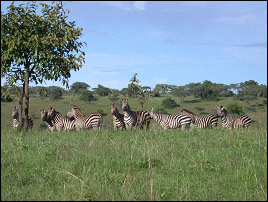
The variety of animals living in the park is extraordinary.
Herds of elephant and buffalo are most likely to
be encountered when they emerge from the dense woodland
to drink at the lakes, while lion, leopard, hyena
and possibly black rhino are still present in small
numbers. Giraffe and zebra are frequently seen in
open woodland, and more than a dozen types of antelope
inhabit the park, most commonly the chestnut impala
with black and white stripes running down its rump
and tail, but also the ungainly topi and the world's
largest antelope, the Cape eland.
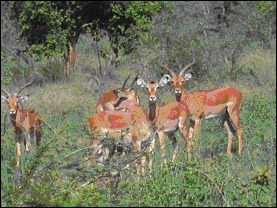 Butare Butare
Butare has been described as the intellectual and
cultural heart of Rwanda, due to the fact that the
National University, the National Institute of Scientific
Research and the National Museum are all sited here.
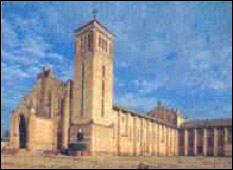
The National Museum of Rwanda is the centrepiece
of Butare, it was opened in 1988 and as a gift from
Belgium´s King Boudain I. In its seven spacious
rooms it houses a wide variety of archaeological
and ethnographical displays, and which would rank
as one of the best museums in the East African region.
The Roman Catholic cathedral was built in memory
of Belgium's Princess Astrid in the 1930s. Is the
largest in the country; an impressive red-brick
building.
For handicrafts, there is an excellent shop opposite
the Ibis Hotel, selling products made by the Co-opérative
des Producteurs Artisanaux de Butare (COPABU) and
there are local craft shops a few kilometers out
of the town at Gihindamuyaga and Gishamvu.
In the way from Kigali to Butare the traditional
ancient palace of the Mwami has been reconstructed.
The Royal Palace of Nyanza is an enormous traditionally
constructed dome, currently maintained as a museum.
In olden times, it was the center of Rwanda and
seat of its monarchy, and the place where the German
colonizers came, at the end of the 19th century.
Gisengy
Situated on the eastern shore of the enormous Lake
Kivu, Gisenyi is split into an upper and lower town.
The former is a grid of busy roads centred around
a small market area and the upper part is an atmospheric
conglomeration of banks, government buildings, old
colonial homesteads and hotels. The waterfront,
with its red sandy beaches and shady palm-lined
avenues, has the captivating air of slightly down-at-heel
tropical beach resort. Given its relatively high
altitude of 1,500 m it has a refreshing climate
with odds with its tropical appearance.
The main attraction of Gisenyi is its relaxing atmosphere.
Wealthier Rwandans, expatriates and travelers looking
to splurge often go for the weekends to the lakeside
of this resort town. It is an interesting place
to wander around, too, whether your interest lies
in the prolific birds that line the lake shore,
the fantastic old colonial buildings that dot the
leafy suburban avenues, lazing around on the beach,
or mixing in to the hustle of the market area.
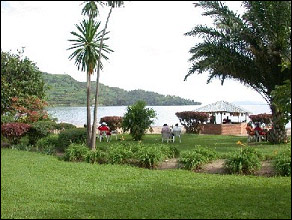
The lake Kivu is extraordinarily beautiful: a vast
inland sea enclosed by the steep, green terraced
hills that are so characteristic of rural Rwanda.
As man would expect at a lake, there are lots of
water sports to keep the energetic and the poseurs
happy, and beer-laden boat trips to the nearby Primus
Brewery to finish off a long hard day. Further afield,
the 6 km. Walk drive to Rubona port offers some
lovely lake views, while at Rubona itself man can
easily arrange to explore the immediate vicinity
in a dugout canoe or pirogue. Meanwhile, to the
south of town is the impressive 328ft-high (100m-high)
waterfall, Les Chutes de Ndaba.
Kigali
Kigali, the capital of Rwanda, is both a modern
business center and a lush garden city, sprawling
attractively over verdant slopes in the very heart
of the land of a Thousand Hills. Kigali. The city
is small but rates big on the attractiveness scale,
dotted as it is with a wide variety of colorful
flora and with a number of viewpoints looking out
over Rwanda's other 999 hills. Kigali does offer
a good number of eateries, clubs and liquid refreshment
joints and is a good place to indulge the senses.
Kigali, despite concessions to modernity, retains
a satisfyingly organic shape and unpretentious low-rise
charm. The compact city center, which surrounds
a busy, colorful market, is studded with souvenir
stalls displaying fine local craftsmanship, it is
noisy and bustling but for an African city surprisingly
clean and safe. Its occupants, form smart-suited
businesspersons to scruffy kids hawking newspapers
or pirated cassettes, go purposefully about their
activities. Foreign and tourist do not feel any
harassment at all apart from hearing "Mushungo"
(white) from different people. The government and
administrative area, in Kacyru quarter on a neighboring
hill, is newer and quieter, with wide streets and
some modern architecture.
Where to stay:
There are two top hotels in Kigali, the Novotel
Umubano Hotel situated in the administrative quarter
and Des Milles Collines Hotel in the center of Kigali.
Both have outdoor swimming pools, tennis courts
and changing money facilities. Recently the Gorilas
Hotel has been opened with a more familiar atmosphere.
Also in the city center is the Okapi Hotel, a short
walk from the market square. Close to the airport
and slightly cheaper is Hotel Chez Lando which offers
very pretty and comfortable chalet style accommodation.
The Hotel Beau Sejor, newly opened is already earning
a reputation for great service at a competitive
price.
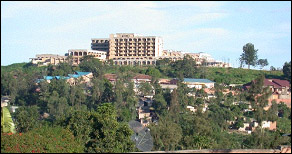
Where to eat:
For a taste of the Orient, Flamingo restaurant serves
the best Chinese in town and in the recently opened
Exotica where one can find the best of India. For
an Italian taste, do not miss Cactus with a selection
of salads, wood-fired pizzas and pasta dishes, Iris
for truly tasty homemade pasta and Sole Lune with
an impressive view of the city. In the high range
many good restaurants can e found in the city: Caprix
des Palais, Karisimbi both offering a very nice
atmosphere; Le panorama, the rooftop restaurant
at Hotel des Milles Collines and the restaurant
from the new Gorillas Hotel.
|
For a more local taste, there are many bars to get
some goat breochettes, Tilapia -the local fish-
and banana beer.
There's an NGO-satisfying array of restaurants clustered
around Place de l'Independence that serve up everything
from regional African fare to up market French dishes
to Italian, Greek, Indian and Chinese cuisines.
Sprinkled among these are numerous bars and a batch
of nightclubs of the please-stay-and-watch-the-sun-come-up
variety, frequented by a sometimes beguiling mixture
of locals, expatriates and folk for hire.
Nightlife:
The nightlife in Kigali is accessible with a fair
degree of safety, though just like most other African
cities it still pays to be cautious and taxis are
recommended after dark. The largest nightclub is
Cadillac, a spacious converted warehouse boasts
several pool tables, two bars and the latest in
pop, traditional Rwandan and Congolese tunes. Maxims's
at Novotel Umubano Hotel is currently very popular
with Kigali's smart set. Cercle Sportif has a truly
energetic feel as it is a sports center by day and
a club by night. The Latest one Planet, very trendy
place.
Nyungwe Forest National Park
The Nyungwe Forest, recently accorded national park
status, is a mountainous 970 sq km protected rainforest
reserve in southern Rwanda. Nyungwe has the largest
single tract of montane forest remaining anywhere
in East or Central Africa. It is rightly celebrated
for the rich variety of its flora and fauna which
is a function not only of its antiquity -it is one
of the oldest forests in Africa, once part of an
interrupted forest belt covering the length of the
Albertine Rift- but also of the wide variation in
elevation.
Harboring more than 75 mammal species, the main
attraction of Nyungwe Forest is its primates with
13-recorded species representing 25% of the total
number in Africa. Of particular interest is the
Ruwenzori colobus, a highly arboreal and acrobatic
leaf-eater, easily distinguished by its contrasting
black overall color and white whiskers, shoulders
and tail tip that move in troops of several hundred
and an estimated 500 chimpanzee. Other primates
likely to be encountered are L'Hoest's monkey, vervet
monkey, olive baboon, grey-cheeked mangabey, and
red-tailed monkey.
The forest comprises at least 200 tree species,
along with a huge variety of small flowering plants,
including wild begonia, more than 100 species of
orchid, and sensational giant lobelias.
Nyungwe is the single most important birdwatching
destination in Rwanda, with more than 275 bird species
recorded, of which the majority are forest specialist
s and 24 are Albertine Rift endemics - birds whose
range is restricted to a handful of montane forests
between southern Uganda and northern Burundi - including
the spectacular Ruwenzori turaco, secretive red-chested
alethe, and several iridescent sunbirds. Equally
remarkable are the great blue turaco, a chicken-size
bird with garish blue, orange and yellow feathers;
the paradise monarch, a long-tailed blue, orange
and white bird and the gigantic forest hornbills.
Parc National des Volcans
When visiting the 'Land of a Thousand Hills', one
should not miss out on the magnificent opportunity
to visit Rwanda's Parc National des Volcans (PNV)
consisting of 125 Km2 of mountain forest and home
to the six Virunga Volcanoes bordering DRC and Uganda
and the world famous mountain gorillas. It is home
to the world's largest number of endangered mountain
gorillas. Numbering in their hundreds, the gorillas
live in a protected area, free from poachers. The
gorillas can be viewed in their natural mountain
habitats at a fairly close range. Best known for
its mountain gorilla inhabitants, what is now the
PNV was originally part of the Albert National Park,
the first national park created in Africa, established
in 1925. Today, the park is managed and protected
by the Rwandan Office of Tourism and National Parks
(ORTPN).
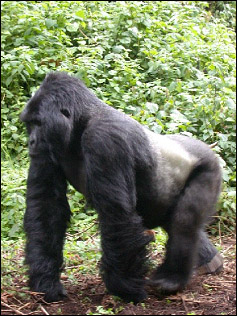
Although hiking and climbing the Volcanoes is currently
not permitted, a gorilla visit can entail anything
from a 1/2 hour to a 4-hour trek through the forest,
led by experienced trackers who have spent their
entire lives living in or close to the forest. Your
trek through the forest will not be easy, but will
be enchanting as you weave through overhanging vines,
moss covered Hagenia trees and giant Lobelias that
thrive in the tropical climate of the forest. You
may spot golden monkeys swinging from the bamboo,
or see wild buffalo, bush duiker and a wide assortment
of bird life. The Virunga ecosystem is composed
of 4 major vegetation zones: bamboo (base altitude),
Hagenia and Hypericum forest (2600-3300m), Sub-alpine
(3300-4000m), and Afro-alpine (4000m+).
It is a privilege to spend an hour watching the
gorillas as they go about their daily routine, feeding,
playing and resting, as you question your primeval
existence and relive the wonder that kept Dian Fossey
living in the forest for almost 18 years. Nothing
can prepare one for the impact of encountering a
fully-grown silverback gorilla: up to three times
as bulky as the average man, yet remarkably peaceable
and tolerant of human visitors. Nor are these words
to describe the thrill of recognition attached to
staring deep into the liquid brown eyes of these
gentle giants, which share some 97% of their genes
with humans.
That mountain gorillas survive today is largely
thanks to Dian Fossey, who is buried at her research
center in the Virungas alongside the animals to
which she dedicated her life. Fossey became a household
name following the release of the biographical film
Gorillas in the Mist, set and shot on location in
the Parc National des Volcans. Critical and public
acclaim ensured that Gorillas in the Mist also served
to raise international awareness of the plight of
the mountain gorilla. A mere 300 of these gentle
giants survive in the wild, half of them resident
in Rwanda, where four habituated groups - ranging
in size from 7 to 33 individuals - can be visited
by up to 32 tourists daily.
Ruhengeri:
Access to the PNV begins in the lively town of Ruhengeri,
situated at the base of the entrance of the park.
Ruhengeri has long been the base point for gorilla
visits and entertains a stunning backdrop of Karisimbi,
Visoke, Mikeno, Sabyinyo, Gahinga and Muhabura volcanoes.
Ruhengeri is easily reached from Rwanda's capital
city, Kigali, and is also only a 45-minute drive
away from Gisenyi and the stunning Lake Kivu. Ruhengeri
is an agreeable place to spend the night before
one goes gorilla tracking, as well as being the
obvious base from which to explore the little-known
but compellingly beautiful Lakes Burera and Ruhondo.
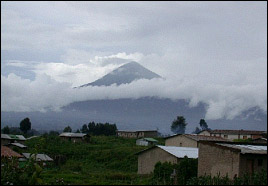
The Kinigi Guest House on the foot of Mount Sabyinyo
was recently fully refurbished, and is now open.
It offers very comfortable accommodation in cottages
for two, four or eight people. It also offers a
good restaurant and bar. Hotel Muhabura in Ruhengeri
town also offers comfortable accommodation in reasonably
priced single and double rooms equipped with mosquito
nets and a good supply of running hot and cold water.
The hotel also features a reasonable restaurant
and bar and is complete with fax and telephone facilities.
Other activities
In order to diversify the tourism attractions in
general, and those of the Volcanoes National Park
in particular, ORTPN has launched some novelties
in response to visitors' demands. Thus three new
activities will be organised in the Volcanoes National
Park:
1. The visit to the grave of the famous Dian Fossey,
and to the gorilla cemetery, where one finds the
grave of Digit, Dian Fossey's favourite gorilla;
2. Climbing Visoke volcano to the crater lake on
its summit;
3. The exploration of lake Marano on Sabyinyo volcano,
and the lakes of Ngezi and Gasindikira, secondary
craters of this volcano.
|

